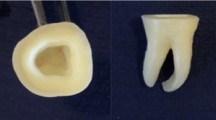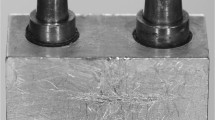Abstract
Objective
This study tested the fracture load of milled and conventionally fabricated polymeric and glass-ceramic three-unit fixed dental prostheses (FDPs) after aging.
Materials and methods
FDPs were fabricated (N = 1,050) from four computer-aided design and computer-aided manufacturing (CAD/CAM) resins: (1) AT (artBlock Temp); (2) TC (Telio CAD); (3) ZP (ZENO PMMA); (4) CT (CAD-Temp); two conventionally fabricated resins, (5) IES (integral esthetic press), (6) CMK (CronMix K), and a glass-ceramic (control) (7) PG (IMAGINE PressX). Specimens of each group were tested immediately after fabrication (n = 15 per material). Seventy-five FDPs per material type were stored in artificial saliva (37°C) and 15 of them were randomly selected after aging (1, 7, 28, 90, and 180 days) for fracture load measurement. The remaining specimens (n = 60 per material) were subjected to chewing simulation (×120.000–1.200.000, 49 N, 5°C/50°C). The data were analyzed using two-way and one-way ANOVA followed by Scheffé test.
Results
The interactions between FDP materials and aging time in both storage media showed a significant impact on the results (p < 0.001). Among saliva storage groups, TC and ZP showed the highest, and PG the lowest fracture load (p < 0.05). AT and CT were not affected from chewing simulation. TC, ZP, and AT presented the highest in ascending order (p < 0.05), PG and CMK showed the lowest fracture load after chewing simulation (p < 0.001).
Conclusions
Aging did not influence the fracture load of FDPs made of CAD/CAM resins. FDPs made of glass–ceramic showed significantly lower fracture load than those of all resin FDPs. Clinical relevance: Considering fracture load measurements, CAD/CAM resins tested could be alternative materials to glass–ceramic for FDP construction.



Similar content being viewed by others
References
Alt V, Hannig M, Wostmann B, Balkenhol M (2011) Fracture strength of temporary fixed partial dentures: CAD/CAM versus directly fabricated restorations. Dent Mater 27:339–347
Goncu Basaran E, Ayna E, Vallittu PK, Lassila LV (2011) Load-bearing capacity of handmade and computer-aided design–computer-aided manufacturing-fabricated three-unit fixed dental prostheses of particulate filler composite. Acta Odontol Scand 69:144–150
Banerjee R, Banerjee S, Prabhudesai PS, Bhide SV (2010) Influence of the processing technique on the flexural fatigue strength of denture base resins: an in vitro investigation. Indian J Dent Res 21:391–395
Rocca GT, Bonnafous F, Rizcalla N, Krejci I (2010) A technique to improve the esthetic aspects of CAD/CAM composite resin restorations. J Prosthet Dent 104:273–275
Lin CL, Chang YH, Liu PR (2008) Multi-factorial analysis of a cusp-replacing adhesive premolar restoration: a finite element study. J Dent 36:194–203
Krämer N, Kunzelmann KH, Taschner M, Mehl A, Garcia-Godoy F, Frankenberger R (2006) Antagonist enamel wears more than ceramic inlays. J Dent Res 85:1097–1100
Giordano R (2006) Materials for chairside CAD/CAM-prodeced restorations. J Am Dent Assoc 137:14S–21S
Chaysuwan D, Sirinukunwattana K, Kanchanatawewat K, Heness G, Yamashita K (2011) Machinable glass-ceramics forming as a restorative dental material. Dent Mater J 30:358–367
Luthy H, Filser F, Loeffel O, Schumacher M, Gauckler LJ, Hammerle CH (2005) Strength and reliability of four-unit all-ceramic posterior bridges. Dent Mater 21:930–937
Rosentritt M, Behr M, Scharnagl P, Handel G, Kolbeck C (2011) Influence of resilient support of abutment teeth on fracture resistance of all-ceramic fixed partial dentures: an in vitro study. Int J Prosthodont 24:465–468
Sterzenbach G, Kalberlah S, Beuer F, Frankenberger R, Naumann M (2011) In-vitro simulation of tooth mobility for static and dynamic load tests: a pilot study. Acta Odontol Scand 69:316–318
Rechenberg DK, Göhring TN, Attin T (2010) Influence of different curing approaches on marginal adaptation of ceramic inlays. J Adhes Dent 12:189–196
Poticny DJ, Klim J (2010) CAD/CAM in-office technology: innovations after 25 years for predictable, esthetic outcomes. J Am Dent Assoc 141:5S–9S
Balkenhol M, Kohler H, Orbach K, Wostmann B (2009) Fracture toughness of cross-linked and non-cross-linked temporary crown and fixed partial denture materials. Dent Mater 25:917–928
Burtscher P (1993) Stability of radicals in cured composite materials. Dent Mater 9:218–221
Manhart J, Schmidt M, Chen HY, Kunzelmann KH, Hickel R (2001) Marginal quality of tooth-colored restorations in class II cavities after artificial aging. Oper Dent 26:357–366
Rosentritt M, Siavikis G, Behr M, Kolbeck C, Handel G (2008) Approach for valuating the significance of laboratory simulation. J Dent 36:1048–1053
Rosentritt M, Behr M, van der Zel J, Feilzer AJ (2009) Approach for valuating the influence of laboratory simulation. Dent Mater 25:348–352
Fischer H, Weber M, Eck M, Erdrich A, Marx R (2004) Finite element and experimental analyses of polymer-based dental bridges reinforced by ceramic bars. J Biomech 37:289–294
Mahmood DJ, Linderoth EH, Vult von Steyern P (2011) The influence of support properties and complexity on fracture strength and fracture mode of all-ceramic fixed dental protheses. Acta Odontol Scand 69:229–237
Scherrer SS, de Rijk WG (1993) The fracture resistance of all-ceramic crowns on supporting structures with different elastic moduli. Int J Prosthodont 6:462–467
Keulemans F, Lassila LV, Garoushi S, Vallittu PK, Kleverlaan CJ, Feilzer AJ (2009) The influence of framework design on the load-bearing capacity of laboratory-made inlay-retained fibre-reinforced composite fixed dental prostheses. J Biomech 42:844–849
Pfeiffer P, Grube L (2006) Effect of pontic height on the fracture strength of reinforced interim fixed partial dentures. Dent Mater 22:1093–1097
Waltimo A, Kononen M (1995) Maximal force and its association with signs and symptoms of craniomandibular disorders in young Finnish non-patients. Acta Ordontol Scand 53:254–258
Fasbinder DJ, Dennison JB, Heys DR, Lampe K (2005) The clinical performance of CAD/CAM-generated composite inlays. J Am Dent Assoc 136:1714–1723
Lehmann F, Spiegl K, Eickemeyer G, Rammelsberg P (2009) Adhesively luted, metal-free composite crowns after five years. J Adhes Dent 11:493–498
Vanoorbeek S, Vandamme K, Lijnen I, Naert I (2010) Computer-aided designed/computer-assisted manufactured composite resin versus ceramic single-tooth restorations: a 3-year clinical study. Int J Prosthodont 23:223–230
Acknowledgments
We are grateful to Merz Dental, Vita Zahnfabrik, Ivoclar Vivadent, and Wieland Dental for the financial and material support.
Conflict of interest
The authors declare no conflicts of interest.
Author information
Authors and Affiliations
Corresponding author
Rights and permissions
About this article
Cite this article
Stawarczyk, B., Ender, A., Trottmann, A. et al. Load-bearing capacity of CAD/CAM milled polymeric three-unit fixed dental prostheses: Effect of aging regimens. Clin Oral Invest 16, 1669–1677 (2012). https://doi.org/10.1007/s00784-011-0670-4
Received:
Accepted:
Published:
Issue Date:
DOI: https://doi.org/10.1007/s00784-011-0670-4




